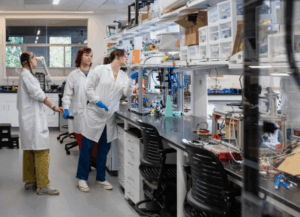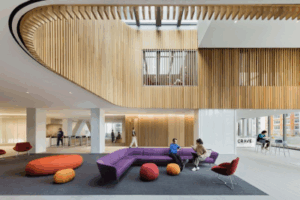Over the years, architecture and design firm Spacesmith has both witnessed and contributed to the evolution of college and university campuses from the inside out. For more than a dozen institutions, the firm has designed learning, living, and social spaces that enhance campus community, functionality, and sustainability.
Using an approach that merges space planning acumen, best practices in sustainability, and a focus on translating end-user needs into unique, often complex architectural solutions, Spacesmith fosters higher education solutions that endure. Examples include classrooms and laboratories at Columbia University and Carnegie Mellon University, as well as sustainable interiors and FF&E for new buildings at campuses from New York University and the University of Pennsylvania to UC Berkeley.
Image Courtesy of: Spacesmith
For users including researchers, faculty and students, Spacesmith has shown how to craft these bespoke, specialized environments, as at the School of Visual Arts’ popular MFA Photography, Video, and Related Media department. In that case, the approach transforms the ground floor of a former warehouse building to marry high-traffic student areas with accessible, yet private faculty offices, focusing on transparency, natural light, and sound control. Reorganizing the program, Spacesmith created a circulation path that intuitively flows in and out of student hubs and faculty spaces.
Customized Solutions for New Demands
There and elsewhere, Spacesmith’s design teams create new, customized spaces that meet the complex demands of highly specialized end-user groups. At Columbia University, this included laboratories for two new physics faculty — among the most technically complex facilities on campus — designed to translate each professor’s unique research needs into a tailored, high-performance environment. To make it happen, Spacesmith cultivates multidisciplinary design expertise to draw expert input from end-user groups and translating the findings into high-functioning, specialized interiors even when new and highly technical project types.
In many of these projects, Spacesmith brings sustainable interiors to campuses in a wide variety of settings, helping universities make their own sustainability standards even more robust. In other projects, Spacesmith advances campus life and learning by designing durable, custom furniture that meets specific user needs and aesthetic goals—without exceeding the cost of standard, off-the-shelf options.

Image Courtesy of: Spacesmith
Often targeting LEED and WELL certifications, the projects reflect Spacesmith’s overall goal of delivering sustainable and healthy materials. Spacesmith requires its manufacturers to complete sustainability and transparency disclosures, and then assesses environmental impact, material health, and commitment to circular economy practices. Their open-source process template has been shared with other design firms and manufacturers over the years.
For projects like the Bancroft-Fulton Student Housing complex at UC Berkeley, California, where Spacesmith is collaborating with architect KieranTimberlake on a new building with 1,600 beds, the team is targeting LEED Gold. As the interior design partner, Spacesmith is helping create shared and communal areas including vibrant student lounges distributed across the residential floors, a two-level dining facility with seating for 500 students, and a range of purpose-driven spaces that support student life and well-being. Multiple study lounges on each floor offer quiet spaces for academic work and collaboration.
Space Planning for Success
In many of the firm’s higher education projects, Spacesmith’s expertise in space planning is essential to creating successful solutions for new facilities. Whether for a contemporary workplace at Cooper Union or the socializing spaces in new mixed-use projects, Spacesmith evaluates and formulates layouts so that they can expand and be combined in various ways, when needed.
Space planning goes beyond calculating headcounts and allocating fixtures, furnishings, and equipment. The goal is to create adaptable environments that support a range of activities throughout the day and across the academic year. To support evolving needs, Spacesmith develops space planning strategies that enable departments to expand or contract over time. Just as importantly, these designs incorporate modularity and flexibility to streamline operations and support day-to-day campus management.
As a result, the higher education spaces Spacesmith designs are accessible, adaptable, and able to support a wide range of users—creating integrated environments that evolve alongside their institutions. For over two decades, this approach has helped clients navigate shifting campus trends and meet the growing needs of increasingly diverse communities.

Image Courtesy of: Spacesmith
Spacesmith is committed to designing purpose-driven spaces that support student life and well-being across campus. Every design decision is made to foster connection, comfort, and community—whether for a classroom, wet lab, communal kitchen, academic center, or lounge.
About Spacesmith
Founded in 1998, Spacesmith is a women-owned architecture, planning, and interior design firm based in New York City. Just as the word “smith” means “to craft, forge or design,” the name Spacesmith reflects the firm’s commitment to the tradition of great craftsmanship, heightened service, design excellence, and context and the environment. With a diverse portfolio of mission-driven clients, Spacesmith has completed work for city, state, and federal agencies – including numerous embassies – schools, nonprofit institutions, and private sector clients in fashion, finance, and media. Spacesmith facilitates and catalyzes each client’s unique purpose. The 30-person firm is made up of a tight-knit group of professionals in the disciplines of architecture, interior design, project management, programming, master planning, sustainability, and wellness. The diversity of the firm’s teams and practice areas allows for knowledge sharing in a world that is constantly evolving.
Feature Image Courtesy of: Spacesmith
View the original article and our Inspiration here


Leave a Reply